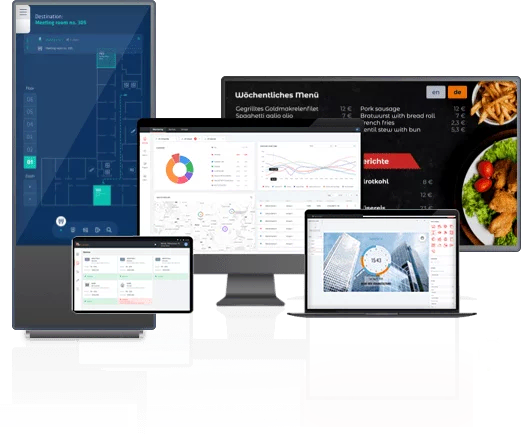
Prior to the days of digital-based solutions, wayfinding was performed via paper maps or physical sign-based mediums. Fast forward to current times, and these outdated methods have been replaced by digital wayfinding solutions as the dominant (and preferred) way to guide people to and from specific points of interest.
In fact, the digital wayfinding signage industry is projected to increase to more than $664 million by 2028, a stat that highlights the technology’s growing popularity around the world. If you’re new to the world of digital wayfinding, this blog will serve as your companion piece – providing an in-depth overview of all aspects of digital wayfinding software and solutions.
What Is Wayfinding Signage?
To keep it as simple as possible, wayfinding signage can be considered anything that provides people with directions – a map, navigation on a wall (e.g., directional arrows), written navigation instructions, etc. Digital wayfinding signage is navigation instructions delivered via a digital medium, such as a video wall, kiosk, or digital signage display (e.g., a wall-mounted screen).
Wayfinding Principles
Although wayfinding might seem like a simple concept, it’s far more complex and intricate than one might imagine. For example, there are several wayfinding “principles” that define modern wayfinding systems, processes, and solutions:
- Identification – creating a unique identification for each location within a building, location, or region.
- Landmarking – developing “landmarks” within an established area for improved visual accuity.
- Path building – building paths that provide people with clear, well-thought-out directions.
- Regional areas – defining regions within an established location for quick identification during travel.
- Focused directions – limiting the number of navigational choices for more efficient travel.
- Clear signage – establishing visual cues and other notifiers for a greater sense of direction, space, and distance.
Read also. How to Choose a Visitor Management Solution.
Types of Wayfinding Signage
Identification
This type of wayfinding signage is by far one of the most commonly seen signage types – it tells visitors, guests, patrons, etc., where they have arrived within a building or other location. For example, if you arrive at the hospital emergency room, it will clearly say “Emergency Room” over the main entrance and within the main doors – pretty straightforward.
Directional
Again, this is another extremely common form of wayfinding signage. The name is self-explanatory, “directional” signage is any type of signage that describes where to go (or where you are currently going). An example of this is a sign on a hallway that reads “Exit This Way.”
Informational
Informational signage includes typical signage such as bathroom signs, exit signs over doorways, what time a business opens and closes, or other “basic” forms of information.
Regulatory
This kind of signage is actually not usually directly related to wayfinding – it includes signage that is required for legal or compliance-related reasons. For example, at a subway station, there might be a sign that reads “Danger – do not cross the tracks.”
The Wayfinding Process
Strategy and Planning
Developing a comprehensive and efficient wayfinding strategy or plan can be a time-intensive process, especially if you aren’t that familiar with wayfinding. Here are a few main areas of consideration to keep top of mind during the strategy and planning process:
- Have a deep understanding of the needs of who will actually be using the wayfinding signage
- Strategy documentation is important – ideas, strategies, sub-strategies, and plans should all be documented along each step of the wayfinding strategy development process.
- Consider how building and location design will impact wayfinding (and vice versa).
Wayfinding Design
Some of the best wayfinding design tips to consider during the wayfinding development process are as follows:
- Research and analyze your intended users’ behavioral patterns, wants, and needs for the location where the wayfinding will be installed.
- Physically test the wayfinding design in-person to see what feels right, and what feels off.
- Don’t forget to include your branding into the design – whether this is through selecting certain hardware styles, including brand colors, logos, etc., branding can play an important role in elevating your signage experience.
Corporate and Commercial Wayfinding Signage
Wayfinding, whether it’s digital or traditional, plays a vital role in both corporate and commercial settings. Visitors, workers, customers, and guests need to know where they are and how to get to where they want to go – signage is how a company can deliver this information. The most important types of wayfinding signage for corporate and commercial environments are as follows:
- Regulatory and compliance
- Information
- Direction
- Identity
Why Wayfinding Signage Is Important
Not all signage is created equal. In the 2020s, digital wayfinding signage is leaps and bounds beyond traditional signage. Why? Most modern solutions offer interactive wayfinding experiences – providing users with digital-based interactive instructions and maps that show exactly how to get to where they want to go in the most efficient way possible, all through an engaging digital content system.
Simply put, wayfinding signage is important because it is a crucial aspect of operating any type of facility, building, or location – if visitors, guests, customers, or workers don’t know where they are or where they are going, it won’t reflect well on your brand.
Benefits
Wayfinding signage plays an important role in how visitors, guests, and patrons experience your building or location – here are some of the top benefits of wayfinding:
- Good wayfinding signage builds trust in your brand and elevates your brand in the eyes of visitors, guests, customers, etc.
- Wayfinding, and especially interactive wayfinding, provides users with a modern, efficient, and seamless method of navigation – increasing the value of your brand.
- Interactive wayfinding is fully self-service – enabling increased worker productivity and optimized user experiences.
- Digital wayfinding is far more aesthetic than traditional forms (e.g., a paper map on a wall), and offers brands total customization, in-depth branding options, and other design-related functions.
- Modern wayfinding platforms can be integrated with other third-party systems and/or platforms, allowing for a more seamless hardware/software environment.
Digital Wayfinding Software
Digital wayfinding software is the backbone of modern end-to-end wayfinding solutions. Most solutions are typically cloud-based or are locally installed on hardware displays such as kiosks or informational screens.
The benefits and advantages of using a digital wayfinding software platform are immense and far-reaching – more customization, easier deployment, faster and more efficient content management, and enhanced end-user experiences are just some of this solution type’s business advantages. When compared to traditional signage systems, digital platforms outperform in nearly every single aspect.
Wayfinding Solutions From friendlyway
Headquartered out of Germany and with more than two decades of digital signage industry experience, friendlyway prides itself on being one of the signage industry’s leading players. Our wayfinding solutions range from modern hardware kiosks and signage displays to our cloud-based friendlyway.NEXT platform, which includes a pre-built software module that allows businesses to create, customize, publish, and manage custom interactive wayfinding maps across their entire fleet of signage devices, entirely over the web.
FAQ
Wayfinding signage is any form of navigational or directional aid, commonly delivered via digital or paper-based mediums, providing guidance via directional arrows, maps, word-based signage, etc.
Common examples of wayfinding include wall-mounted maps of a building floor, directional signage in hallways, and signage that is detailing emergency exits.
Wayfinding can be considered a subset of signage because it involves digital or traditional signage to display navigational directions or aids. Wayfinding is a subset of signage, but signage does not necessarily need to be wayfinding-related.
The four most common forms of signage: identity, direction, information, and regulation.




